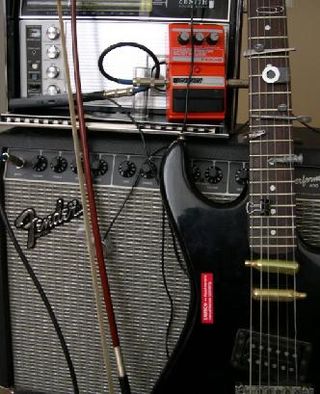
An overtone is any resonant frequency above the fundamental frequency of a sound. In other words, overtones are all pitches higher than the lowest pitch within an individual sound; the fundamental is the lowest pitch. While the fundamental is usually heard most prominently, overtones are actually present in any pitch except a true sine wave. The relative volume or amplitude of various overtone partials is one of the key identifying features of timbre, or the individual characteristic of a sound.

In music, extended technique is unconventional, unorthodox, or non-traditional methods of singing or of playing musical instruments employed to obtain unusual sounds or timbres.
In music, a drone is a harmonic or monophonic effect or accompaniment where a note or chord is continuously sounded throughout most or all of a piece. A drone may also be any part of a musical instrument used to produce this effect; an archaic term for this is burden such as a "drone [pipe] of a bagpipe", the pedal point in an organ, or the lowest course of a lute. Α burden is also part of a song that is repeated at the end of each stanza, such as the chorus or refrain.

Claude Vivier was a Canadian contemporary composer, pianist, poet and ethnomusicologist of Québécois origin. After studying with Karlheinz Stockhausen in Cologne, Vivier became an innovative member of the "German Feedback" movement, a subset of what is now known as spectral music. He was also among the first composers in either Europe or the Americas to integrate elements of Balinese music and gamelan in his compositions, alongside Lou Harrison, John Cage and fellow Québécois Colin McPhee.
Variations for Winds, Strings and Keyboards is an orchestral piece composed in 1979 by Steve Reich. The piece is scored for oboes, flutes, full brass, strings, pianos, and electric organs. Variations was Reich's first orchestral piece.
Divertimento for String Orchestra Sz.113 BB.118 is a three-movement work composed by Béla Bartók in 1939, scored for full orchestral strings. Paul Sacher, a Swiss conductor, patron, impresario, and the founder of the chamber orchestra Basler Kammerorchester, commissioned Bartók to compose the Divertimento, which is now known to be the pair's last collaborative work.

A sound icon is a grand piano standing on its side. It is primarily played by bowing the strings. It was the invention of Romanian-French composer Horațiu Rădulescu, who featured the instrument in several of his pieces.
Siddhartha is an orchestral suite by Canadian composer Claude Vivier, which was completed in 1976.
Shiraz is a virtuosic piano piece by Claude Vivier, written in 1977. It is named after the eponymous Iranian city, and contains a flurry of interlocking rhythmic combinations and pulses at great speed. Vivier was inspired to write the piece after listening to blind singers perform in the city's market square. He wrote in the piece's program notes how he found Shiraz to be, "a pearl of a city, a diamond vigorously cut."
Lonely Child is a piece for soprano and orchestra by Claude Vivier, written in 1980. It is arguably his most well-known piece, and is considered a hallmark composition in the genre of spectral music.

Orion is a 1979 orchestral suite by Claude Vivier, inspired by the constellation of the same name. It is among the first compositions in Vivier's catalogue to delve into a unique compositional style he referred to as the jeux de couleurs. A typical performance lasts around thirteen minutes.
Wo bist du Licht! is a 1981 piece for mixed orchestra, mezzo-soprano and tape by Canadian composer Claude Vivier. Vivier completed the piece in early 1981, on a commission from the Canadian Broadcasting Corporation. It is dedicated to Rober Racine. The notes given by Vivier in the finished manuscript describe it as follows: "A meditation on human suffering, this piece is intended as one long continuous melody. The music can be perceived from three different aspects: formal, melodic, or textual."
Kopernikus is a 1979 opera in two acts by Canadian composer Claude Vivier, inspired by the astronomer of the same name. It is the only opera of three that Vivier completed prior to his death in 1983. A typical performance lasts around seventy minutes.
Pianoforte is a 1975 piano piece by Canadian composer Claude Vivier.
Canadian composer Claude Vivier's Pièces are a series of four chamber compositions for two performers, with varying instrumentation. They were all written in the year of 1975.
Bouchara is a 1981 work for mixed chamber ensemble by Canadian composer Claude Vivier. It was originally intended to serve as an interlude for his unfinished opera Rêves d'un Marco Polo (1983-), but was published independently of the opera after weeks of deliberation. A typical performance lasts around twelve minutes.
Canadian composer Claude Vivier (1948–83) wrote four extant pieces for the tape recorder, in the musique concrète tradition established by French composer Pierre Schaeffer in the 1940s. Multiple other pieces from his career include the tape machine being used as an additional instrument to various ensembles. The majority of these compositions were a result of Vivier studying with Gottfried Michael Koenig at the Institute for Sonology in Utrecht.
Cinq chansons pour percussion is a 1980 work for solo percussionist by Canadian composer Claude Vivier. It is an example of an extended American gamelan, featuring a very large array of percussion instruments that include gongs and bells from Chinese, Japanese, Indonesian and Thai origin.
Glaubst du an die Unsterblichkeit der Seele? is an unfinished 1983 chamber piece by Canadian composer Claude Vivier. It is one of his most famous compositions, as the libretto is claimed by some to have predicted the composer's own murder in March of the same year. The piece was left incomplete and unrevised with just three short movements, a typical performance lasting around eight minutes.
Et je reverrai cette ville étrange is a 1981 work for chamber ensemble by Canadian composer Claude Vivier. It is an extreme manifestation of monody, with all instruments playing in unison with a continuous melodic line throughout the piece. Musicologists generally view this piece as one of the apexes of his timbral concept, jeux de couleurs.




